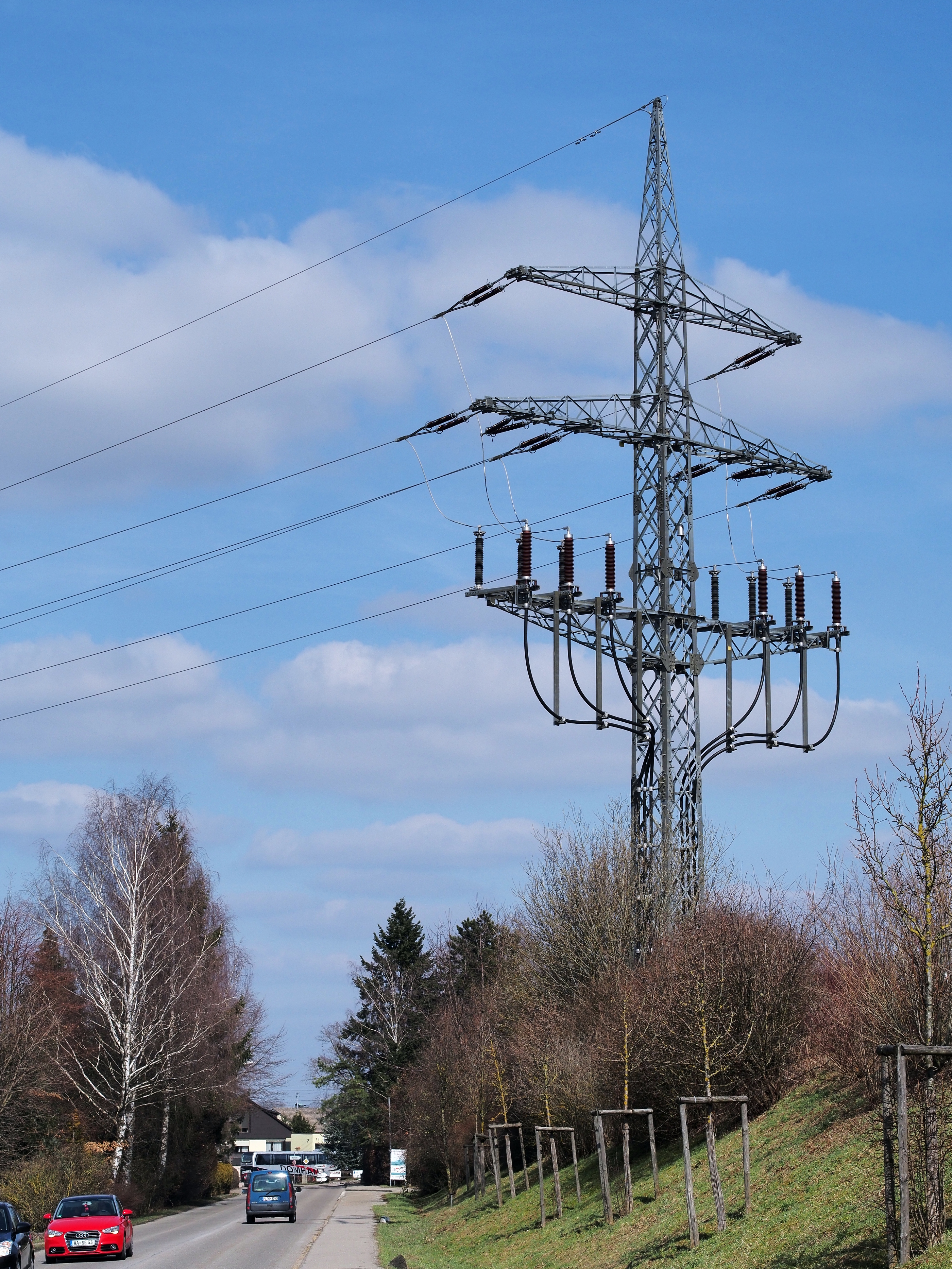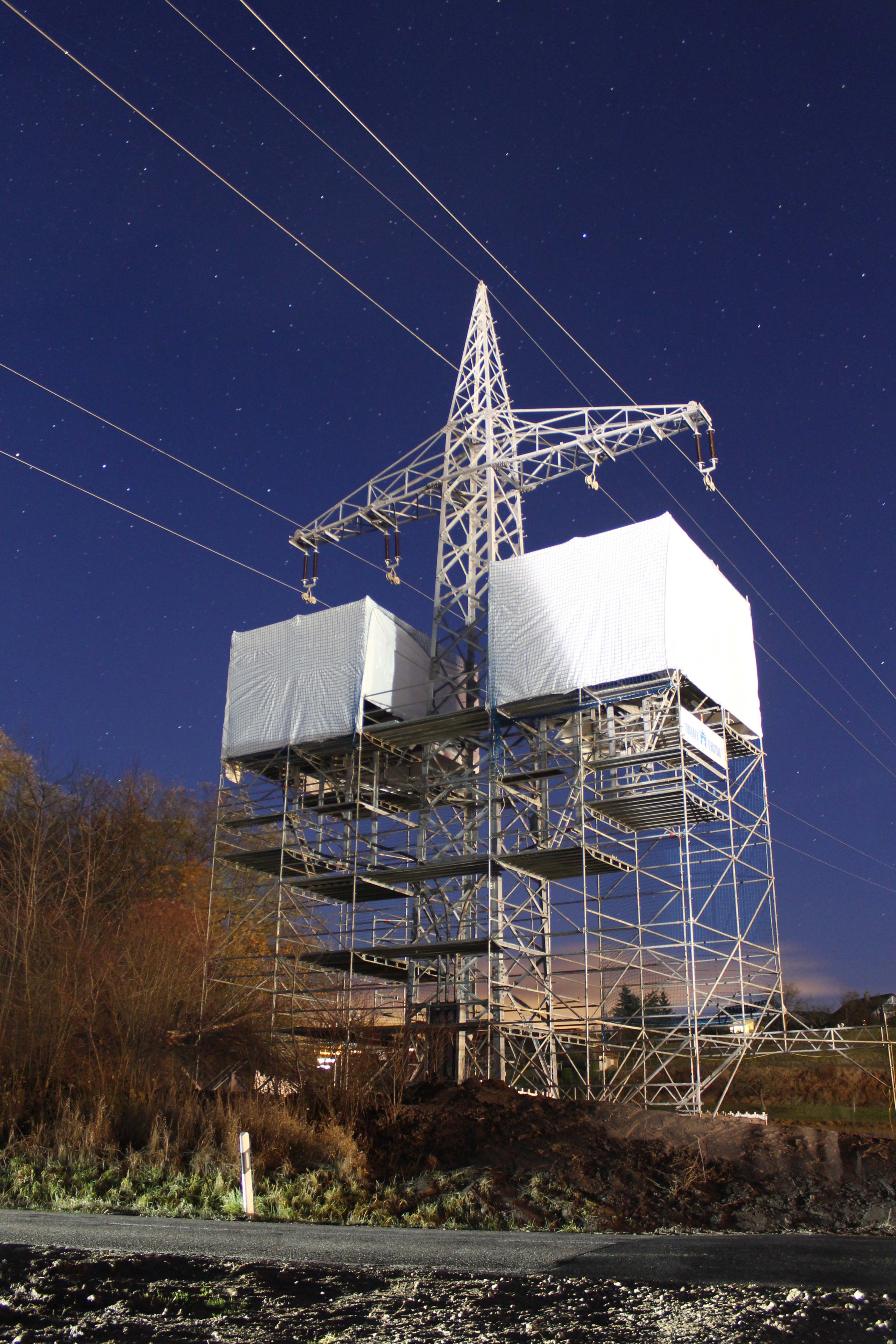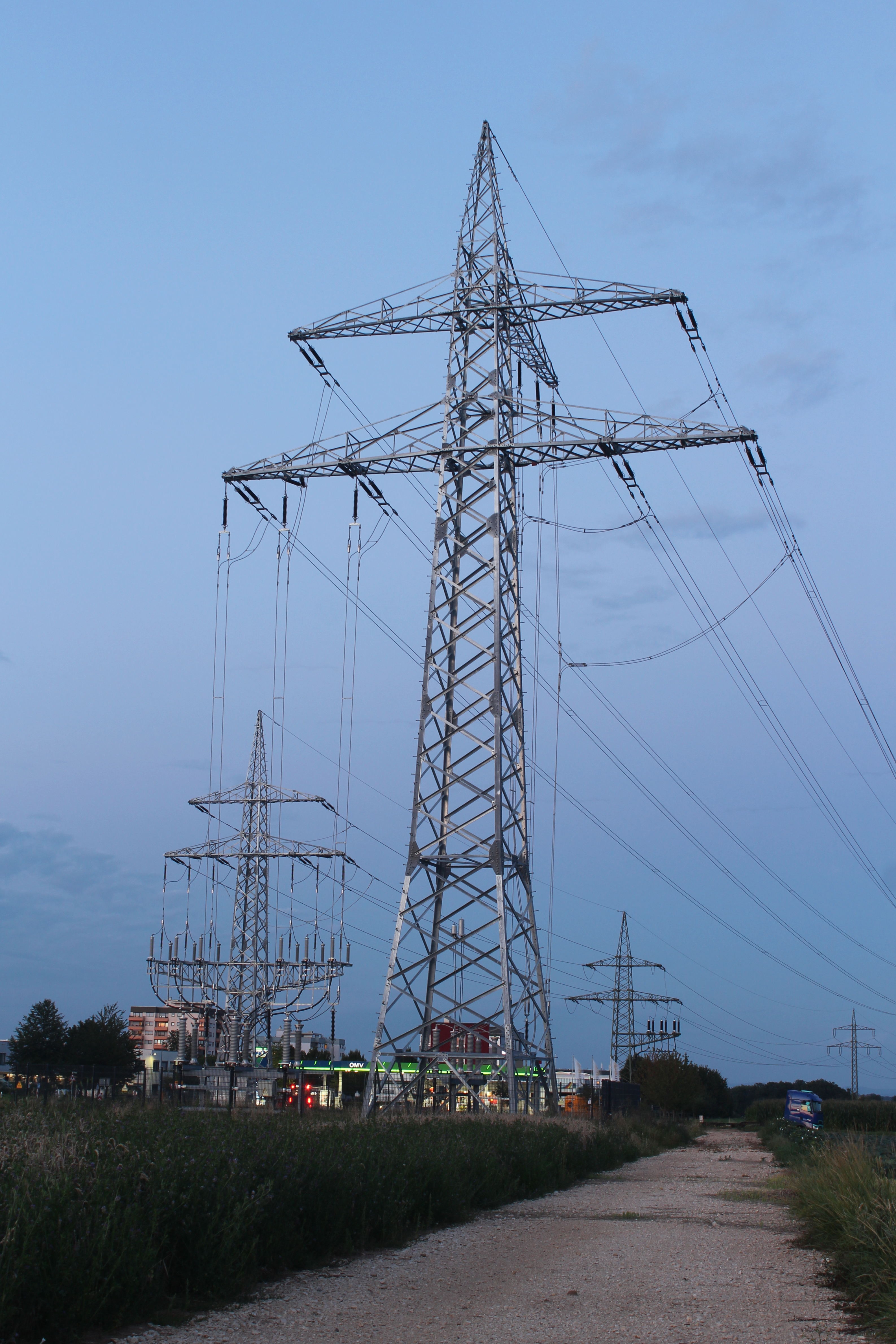Dead-end Tower on:
[Wikipedia]
[Google]
[Amazon]
 A dead-end tower (also anchor tower, anchor pylon) is a fully self-supporting structure used in construction of
A dead-end tower (also anchor tower, anchor pylon) is a fully self-supporting structure used in construction of  Since dead-end towers require more material and are heavier and costlier than suspension towers, it is uneconomic to build a line with only self-supporting structures.D.G. Fink, H.W. Beaty, ''Standard Handbook for Electrical Engineers Eleventh Edition'', McGraw-Hill, 1978 , pp. 14-80, 14-81
Dead-end towers are used at regular intervals in a long transmission line to limit the cascading tower failures that might occur after a conductor failure. An in-line dead-end tower will have two sets of strain insulators supporting the lines in either direction, with the lines connected by a jumper between the two segments. Dead-end towers can resist unbalanced forces due to line weight and tension, contrasted with
Since dead-end towers require more material and are heavier and costlier than suspension towers, it is uneconomic to build a line with only self-supporting structures.D.G. Fink, H.W. Beaty, ''Standard Handbook for Electrical Engineers Eleventh Edition'', McGraw-Hill, 1978 , pp. 14-80, 14-81
Dead-end towers are used at regular intervals in a long transmission line to limit the cascading tower failures that might occur after a conductor failure. An in-line dead-end tower will have two sets of strain insulators supporting the lines in either direction, with the lines connected by a jumper between the two segments. Dead-end towers can resist unbalanced forces due to line weight and tension, contrasted with
Pyloninblore.jpg, A branch pylon in the strict sense in


 A special kind of a dead-end tower is a termination pylon, also called a terminal tower. It is used when the overhead power line terminates, and is connected to substation equipment, or transitions to underground cable.
For voltages below 30 kV also pylon transformers are used.
A special kind of a dead-end tower is a termination pylon, also called a terminal tower. It is used when the overhead power line terminates, and is connected to substation equipment, or transitions to underground cable.
For voltages below 30 kV also pylon transformers are used.
overhead power line
An overhead power line is a structure used in electric power transmission and distribution to transmit electrical energy across large distances. It consists of one or more uninsulated electrical cables (commonly multiples of three for three-p ...
s. A dead-end transmission tower
A transmission tower, also known as an electricity pylon or simply a pylon in British English and as a hydro tower in Canadian English, is a tall structure, usually a steel lattice tower, used to support an overhead power line.
In electrical gri ...
uses horizontal strain insulator
A strain insulator is an electrical insulator that is designed to work in mechanical tension (strain), to withstand the pull of a suspended electrical wire or cable. They are used in overhead electrical wiring, to support radio antennas and over ...
s at the end of conductors. Dead-end towers may be used at a substation as a transition to a "slack span" entering the equipment, when the circuit changes to a buried cable, when a transmission line changes direction by more than a few degrees, or at intervals along a straight run to limit the extent of a catastrophic collapse.
 Since dead-end towers require more material and are heavier and costlier than suspension towers, it is uneconomic to build a line with only self-supporting structures.D.G. Fink, H.W. Beaty, ''Standard Handbook for Electrical Engineers Eleventh Edition'', McGraw-Hill, 1978 , pp. 14-80, 14-81
Dead-end towers are used at regular intervals in a long transmission line to limit the cascading tower failures that might occur after a conductor failure. An in-line dead-end tower will have two sets of strain insulators supporting the lines in either direction, with the lines connected by a jumper between the two segments. Dead-end towers can resist unbalanced forces due to line weight and tension, contrasted with
Since dead-end towers require more material and are heavier and costlier than suspension towers, it is uneconomic to build a line with only self-supporting structures.D.G. Fink, H.W. Beaty, ''Standard Handbook for Electrical Engineers Eleventh Edition'', McGraw-Hill, 1978 , pp. 14-80, 14-81
Dead-end towers are used at regular intervals in a long transmission line to limit the cascading tower failures that might occur after a conductor failure. An in-line dead-end tower will have two sets of strain insulators supporting the lines in either direction, with the lines connected by a jumper between the two segments. Dead-end towers can resist unbalanced forces due to line weight and tension, contrasted with suspension tower
In an electric power transmission line, a suspension tower is where the conductors are simply suspended from the tower, the mechanical tension being the same on each side.
In this case, the tower is supposed to carry a downward force, and a later ...
s which mostly just support the conductor weight and have relatively low capacity for unbalanced load. Dead-end towers may use earth anchor
An earth anchor is a device designed to support structures, most commonly used in Geotechnical engineering, geotechnical and construction applications. Also known as a ground anchor, percussion driven earth anchor or mechanical anchor, it may be ...
cables to compensate for the asymmetric attachment of the conductors. They are often used when the power line must cross a large gap, such as a railway
Rail transport (also known as train transport) is a means of transport that transfers passengers and goods on wheeled vehicles running on rails, which are incorporated in tracks. In contrast to road transport, where the vehicles run on a pre ...
line, river
A river is a natural flowing watercourse, usually freshwater, flowing towards an ocean, sea, lake or another river. In some cases, a river flows into the ground and becomes dry at the end of its course without reaching another body of wate ...
, or valley
A valley is an elongated low area often running between Hill, hills or Mountain, mountains, which will typically contain a river or stream running from one end to the other. Most valleys are formed by erosion of the land surface by rivers ...
.
Dead-end towers may be constructed of the same materials as other structures of the line. They may be steel or aluminum lattice structures, tubular steel, concrete, or wood poles.
Branch pylon
Dead-end towers are also employed at branch points as branch pylons. A tower at which the power line runs further as overhead line and as underground cable is a branch tower for a cable branch. A branch pylon is used to start a line branch. The branch pylon is responsible for holding up both the main line and the start of the branch line. This makes a branch pylon also an anchor pylon since it must resist forces from both lines. Branch pylons frequently, but not always, have one or more cross beams transverse to the direction of travel of the line for the admission of the branching electric circuits; some also have cross beams of the branching electric circuits lying in the direction of travel of the main line. Branch pylons without additional cross beams are occasionally constructed.India
India, officially the Republic of India (Hindi: ), is a country in South Asia. It is the seventh-largest country by area, the second-most populous country, and the most populous democracy in the world. Bounded by the Indian Ocean on the so ...
Anlage901_Mast52_29032016_1.JPG, Cable branch
110-kV-Einschleifung.jpg, Loop-in of the branch, no through line
Dülmen, Umspannstation -- 2014 -- 0005.jpg, Simple branch within the span
Termination pylon

 A special kind of a dead-end tower is a termination pylon, also called a terminal tower. It is used when the overhead power line terminates, and is connected to substation equipment, or transitions to underground cable.
For voltages below 30 kV also pylon transformers are used.
A special kind of a dead-end tower is a termination pylon, also called a terminal tower. It is used when the overhead power line terminates, and is connected to substation equipment, or transitions to underground cable.
For voltages below 30 kV also pylon transformers are used.
Long spans
For crossings of large bodies of water, wide freeways, or valleys, where the span width of the conductors is very long, specific constructions must be used to achieve a wider distance between the conductors, mostly to prevent short-circuits which may occur when conductors come in contact with one another due to wind or other interferences. These towers may be built as H-frame towers, or may have each conductor placed on a single tower or mast. In every case, these towers are built more stable than most of the other towers used, as the wide span between towers means that much greater forces are placed on these towers.Switch pylon
Anchor pylons may also have aswitch
In electrical engineering, a switch is an electrical component that can disconnect or connect the conducting path in an electrical circuit, interrupting the electric current or diverting it from one conductor to another. The most common type of ...
attached to their crossbeam. These so-called switch pylons are operated from the ground by the use of long rods. The attachment of circuit breakers to pylons is only practical when voltages are less than 50 kV.
Sequences
Sequences of two or more strainer pylons are uncommon in a powerline because strainers require twice as manystrain insulator
A strain insulator is an electrical insulator that is designed to work in mechanical tension (strain), to withstand the pull of a suspended electrical wire or cable. They are used in overhead electrical wiring, to support radio antennas and over ...
s as ordinary pylons. Longer wire sections thus reduce installation work and cost. Sequences of strainers are sometimes used at powerlines crossing valleys, or where the powerline runs a path with curves.
See also
*Suspension tower
In an electric power transmission line, a suspension tower is where the conductors are simply suspended from the tower, the mechanical tension being the same on each side.
In this case, the tower is supposed to carry a downward force, and a later ...
* Transposition tower
In electrical power transmission, a transposition tower is a transmission tower that changes the relative physical positions of the conductors of a transmission line in a Polyphase system. A transposition tower allows these sections to be connect ...
References
{{DEFAULTSORT:Anchor Pylon Pylons Overhead power lines